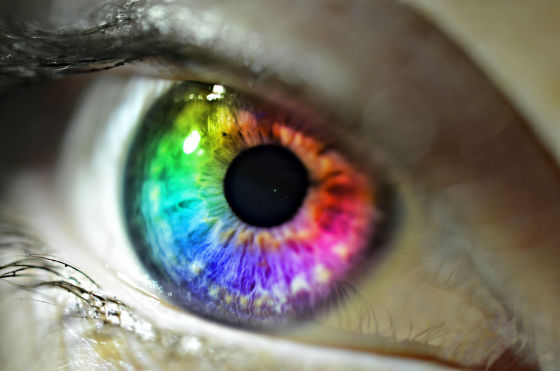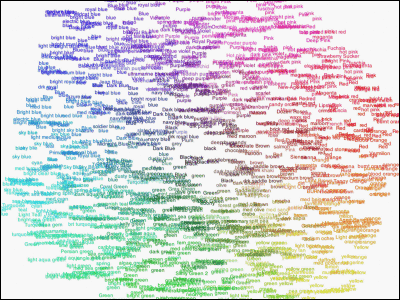There are cultures with only three colors in the world, why the number of words expressing colors depends on the language?

byPaul
The number of words representing colors, such as blue, red, yellow and green, varies depending on the culture, and in industrialized culture there are many color names used, but in industries not industrialized there are few color names I know that. Why the number of color names differs depending on the culture is not clear in our previous studies, but it is a different approach from the theory that the research team has been using for 50 years, a different approach to elucidate this problem I am challenging.
Color naming across languages reflects color use
http://www.pnas.org/content/early/2017/09/12/1619666114
Analyzing the language of color | MIT News
http://news.mit.edu/2017/analyzing-language-color-0918
Languages do not have all the same number of terms for colors - scientists have a new theory why
https://theconversation.com/languages-dont-all-have-the-same-number-of-terms-for-colors-scientists-have-a-new-theory-why-84117
People who live in an industrialized cultural area often have 11 words representing black, white, red, green, yellow, blue, brown, orange, pink, purple, and gray. Of course, if it is a designer or an artist, it is possible to express more detailed colors in words such as "turquoise" "amber" "indigo". This is roughly 50 to 100 pieces.
On the other hand, it is known that the number of "words representing color" of people living in cultural areas not industrialized is fewer. In Papua New Guinea's "Berinmo" language there are only five words to describe colors, Bolivian Amazon's "Tsimane" language has only three words: black, white and red.
As mentioned above, why the number of words expressing colors depends on culture has been studied so far, but the reason is not clear.
The history of research on words expressing colors dates back to two researchers, Professor Brent Berlin and professor Paul Kay who were active in the 1960s. Two researchers gathered data on color names for 20 languages and examined common points in their respective languages. At this time, when there are only two names representing colors in a certain culture, it is white and black. And the third was red, the fourth and fifth were green and yellow, the sixth were blue, and the seventh became tea.

byBen Mortimer
The fact that the order of color names in multiple languages is the same means that they are named from conspicuous colors in many cultures and that one color name is one, They thought. In other words, the colors black, white, red, green, yellow and blue will be "conspicuous" in order from black.
However, thereafter, when researchers gathered and analyzed data from 110 cultural languages that were not industrialized, several "exceptions" that the above rule did not apply appear. In addition, the two hypotheses that "a name is naturally attached from a color which is inherently conspicuous" does not explain "why does the word representing color increase when it is industrialized?" Since the structure of human vision does not change according to culture, the fact that "there is inherently outstanding color" should not be affected by industrialization or non-industrialization.
Therefore, the research team of Massachusetts Institute of Technology, University of Rochester and researchers of the National Institute of Health, based on a new hypothesis different from past research that "color names can be attached to improve communication efficiency" I did research. Researchers told 40 subjects who speak the Amazon language "Tsimane"Munsell color systemI gave the following table which selected 80 colors from.

Each color chip used in the table is partitioned into a grid with black chips, and the colors arranged are changed at a fixed rate. Subjects looked at this color table and labeled what colors were shown.
At this time, the acquired data isInformation theoryBy quantitatively analyzing supplier analysis, it is quantified how much people's explanations differ. In other words, when one word such as blue or green is often used to describe many color chips, the chip is a high supply pricier. When many people explained the chip in the same language, the chip means that the supply monkey is low, but when many people use different words to explain the color of one chip, that chip The supply monkey is expensive.
When I went to the people who talked about Tsimane as well as those who talked about Tsimane, I heard that the cold colors such as blue and green are on average higher than the warm color such as red and orange, compared to the warm colors such as English and Spanish.
After that, researchersWorld Color SurveyThe data of 110 languages in non-industrialized cultures were compared using the data of. Then, in these languages, a similar law was confirmed.
In the table with 80 color chips, the same amount of warm color and cold color exists. However, in many languages, when classifying cold and warm colors finely, warm color has more colors, so the number of chips represented by "blue" is larger than the number indicated by "yellow" or "red" It is said that. From here, researchers conclude that people named them preferentially from warm colors.
In order to explore this reason researchers analyzed a database consisting of 20,000 images labeled by Microsoft, the warm color was used for the foreground of the photo in many images, the cold color was used for the background etc. I understood that it was done. In other words, rather than the cold colors used in the background such as the sky and the forest, people are related to the warm-colored "things" in front of them, and because they are used for topics with others, the warm colors are preferentially named That is why.

byxommandcity
Although the results of this research do not clarify the relationship between the number of color names and industrialization, a different approach from the theory that "existing innovative colors preferentially be named" existed so far It is said to be the success of the first step of the.
To further advance this hypothesis, researchers said they wanted to study the languages of areas covered with snow and deserts. Due to the background color being different in these areas, different experimental results are expected to be obtained.
Related Posts:
in Note, Posted by darkhorse_log







